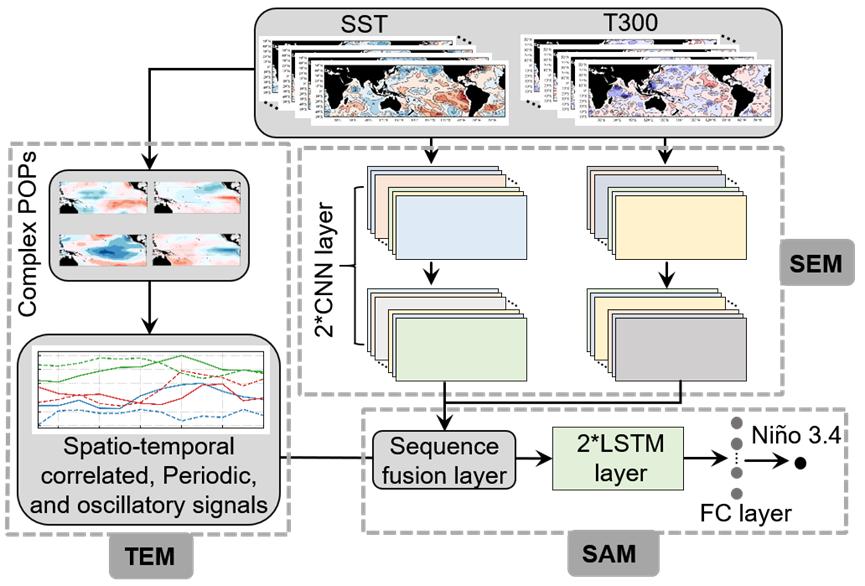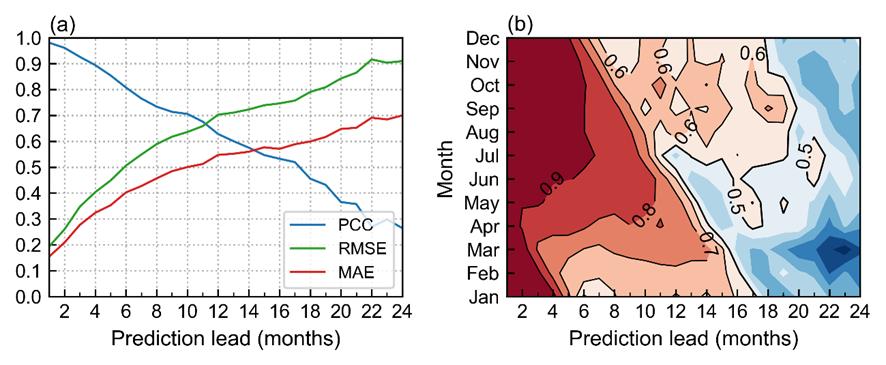Using Artificial Neural Network Helps Improve ENSO Predictions
El Nino-Southern Oscillation (ENSO) is the strongest interannual climate phenomenon originating from ocean-atmosphere interactions in the equatorial Pacific, which influences the global climate system by atmospheric bridges and oceanic pathways. An accurate and timely prediction of ENSO is necessary for a reliable weather and climate forecasts around the global.
Artificial neural network (ANN) has emerged as a powerful approach for improving ENSO-related climate prediction and projection. How to effectively combine ANNs with ENSO-related patterns using physical-based analysis method and to further enhance ENSO prediction skills is a novel research way to go forward.
Recently, Ph. D. student ZHOU Lu of Prof. ZHANG Rong-Hua's team from the Institute of Oceanology of the Chinese Academy of Sciences (IOCAS) developed a novel hybrid model by combining principal oscillation pattern (POP) analyses with convolutional neural network (CNN)-long short-term memory (LSTM) algorithm, which is then used to improve Nino-3.4 sea surface temperature (SST) index prediction with great success.
The study was published in Advances in Atmospheric Sciences on Mar. 8.
Specifically, the POP analysis method used in hybrid modeling is a technique to extract periodically propagating patterns composed of real and imaginary parts of the POP modes from a multi-component system. Based on the spatio-temporal correlated properties of ENSO-related anomaly fields, POP analyses were first used to extract quasi-periodically propagating patterns from the complex climate system.
Furthermore, the specific POP patterns can be selected to formulate a POP-based prediction model or incorporated into a data-driven model configuration, such as CNN-LSTM, to formulate hybrid model, named as POP-Net. "The hybrid model constructed by this method acts to reduce the difficulty for ANNs to search for predictable information in an automatic way and thus achieves higher prediction accuracy for ENSO," said ZHOU.
As designed, the POP-based pre-processing acts to enhance ENSO-related signals of interest while filtering out unrelated noise. By comparing with POP-based model and CNN-LSTM individually, POP-Net indeed exhibits its ability to improve ENSO prediction skills, with correlation coefficients exceeding 0.5 up to a lead time of 17 months during the 1994-2020 validation period. Moreover, the POP-Net also alleviates the spring predictability barrier (SPB).
The superiority of the POP-Net over the other two individually configured models in terms of ENSO predictions indicates that value-added artificial neural networks for improved ENSO predictions are feasible by including the process-oriented analyses to enhance signal representations.
"These preliminary results are extremely encouraging and also provide new ideas for hybrid modeling studies based on the combinations of physical-based analysis methods with neural networks," said Prof. ZHANG.
This research was supported by the Strategic Priority Research Program of the Chinese Academy of Sciences and the National Natural Science Foundation of China.

Fig. 1 Architecture of the POP-Net model configured for the Nino-3.4 index prediction

Fig. 2 ENSO prediction skills assessed for the POP-Net. (a) The all-season Pearson correlation coefficient (PCC; blue), root mean square error (RMSE; green), and mean absolute error (MAE; red). (b) The correlation coefficients between the POP-Net predicted and observed Nino-3.4 SST index as a function of lead months and start months.
Zhou, L. and R.-H. Zhang. (2022). A hybrid neural network model for ENSO prediction in combination with principal oscillation pattern analyses. Adv. Atmos. Sci., https://doi.org/10.1007/s00376-021-1368-4.
ZHANG Rong-Hua
Institute of Oceanology
E-mail: rzhang@qdio.ac.cn
(Editor: ZHANG Yiyi)